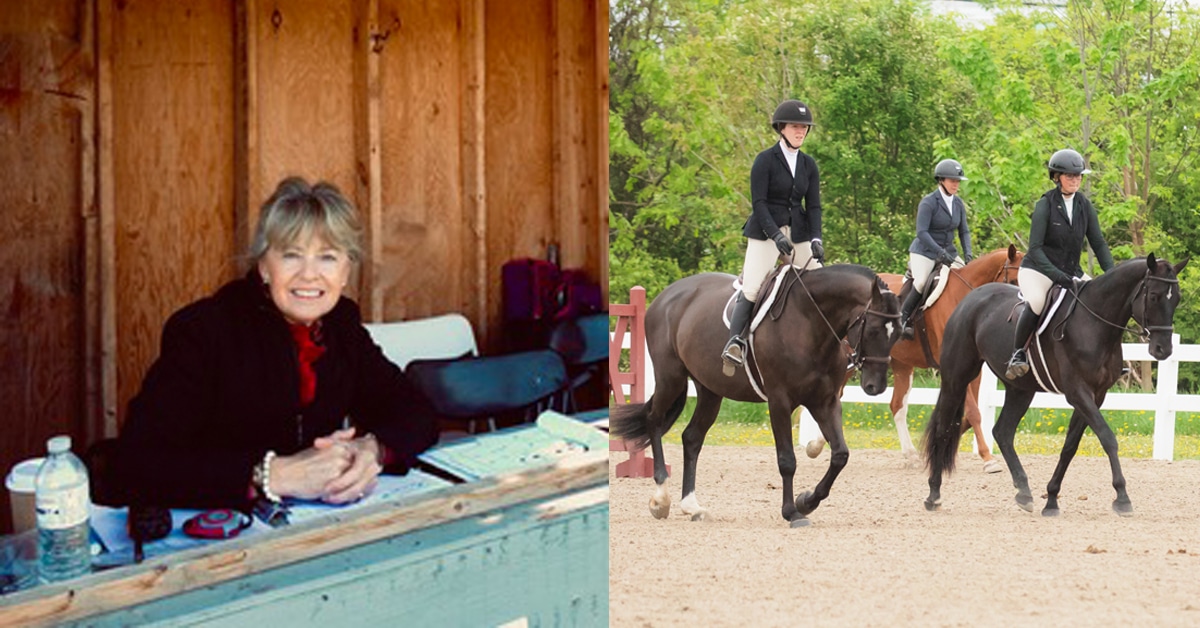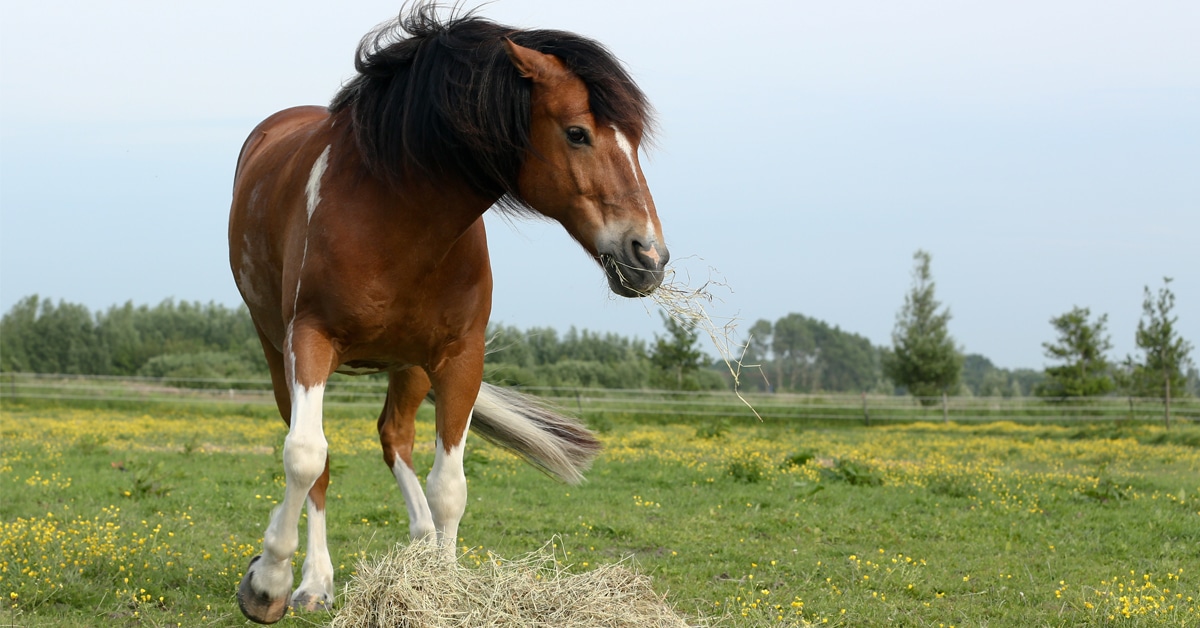Equine herpesvirus 1 has been endemic in horse populations worldwide for far longer than humans have been studying it, and eradication is not an option. There is only one correct response to the threat of EHV-1: from the national federation to the owner of a child’s pony, everyone in the horse industry must take personal responsibility to do their part to minimize the possibility of an outbreak, and take the appropriate steps when an outbreak inevitably happens.
A dangerous mutation
Researchers have learned that there are multiple strains of the EHV-1 virus. The type for which a vaccine currently exists is now generally known as the “wild strain,” whose most serious consequence is usually abortion, the primary purpose for the routine “rhino” vaccinations. In 2001, following two EHV-1 outbreaks in North America whose characteristics raised red flags in the veterinarian community, a previously unknown mutation of EHV-1 was identified. A disease that had been quietly in the background for generations was suddenly front and centre.
Dr. Peter Timoney of the Gluck Research Center at the University of Kentucky is considered one of the world’s foremost experts on infectious diseases in horses. The new strain, he says, has only a single point mutation, but it’s a mutation that has a powerful impact. “The mutation is directly involved in virus replication,” he explains. “It is more contagious.” The mutated strain has a much higher level of viremia (presence in the blood). It reaches a peak more quickly and lasts longer during that period, which means that an infected horse is shedding more virus for longer, making it more contagious. Additionally, this strain has a much higher clinical attack rate than the wild strain, and a mortality rate that Dr. Timoney says may be as high as 40%. “In outbreaks associated with a high clinical attack rate and neurological disease, 75% of those were associated with the strain with that single point mutation which controls replication.”
Research continues in the search for a vaccine that would protect horses against this strain of EHV-1, and Dr. Timoney is optimistic that one will be found. In the meantime, horse owners should continue routine vaccinations with the vaccine that currently exists. While that vaccine doesn’t protect horses against the neurological strain or against the wild strain turning neurological (which does occur), there is what Dr. Timoney describes as “a degree of relative protection.” Research conducted by his late colleague at the GRC, Dr. George Allen, concluded that horses which were vaccinated using the current vaccine and later exposed to the mutant strain were less likely to develop neurological symptoms. “Horses that are vaccinated also have a shorter shedding period of the virus,” he explains.
It’s not protection, it’s mitigation; but there is sufficient value to reducing the contagiousness that vaccination continues to be recommended, except in the instance of an outbreak. “There may be some adverse affects to a population that has been exposed to an outbreak of EHV-1,” says Timoney. “I would not vaccinate in the face of an outbreak.”
Government’s limited reach
EHV-1 is only one of a number of potentially fatal infectious diseases in horses, so the rationale behind adopting good management practices with one’s own horses is neither new nor temporary. But EHV-1 brings its own set of complexities, including the fact that it is not a reportable disease with federal government agencies in Canada or the US. “It’s an endemic disease, so it will never be reportable,” says Dr. Mary Bell, an equine practitioner and FEI vet who has been the co-chair of Equine Canada’s combined Health and Welfare Committee since 2008. Previous to that, she was chair of the EC Equine Health Committee and Medication Committee. Bell says that for the past 11 years she has been part of an effort to get the Canadian Food Inspection Agency (CFIA) to designate EHV-1 as immediately notifiable, which would mean laboratories conducting EHV-1 tests must immediately notify the CFIA. “We are never going to have any federal governmental regulatory system for an endemic disease,” she says. “But if it were possible to have a monitoring system similar to what they’ve had with equine infectious anaemia, there would at least be information provided as to the presence of disease and where it was present.” Enter the provinces.
There is currently no standard protocol for EHV-1 from province to province, but progress is being made. Ontario’s Ministry of Agriculture and Food (OMAFRA), has been a leader with respect to EHV-1. In Ontario, the neurological strain of the disease is immediately notifiable. Alberta is the only other province in which EHV-1 is an immediately notifiable disease, but Bell says other provinces are working on changes. In BC the disease is not notifiable, but it’s on a proposed list.
Because the Ontario government has the authority to identify cases of EHV-1, the first step toward controlling an outbreak is greatly aided through communication, unhindered by the Privacy Act. “This isn’t a matter of superseding privacy,” says Dr. Greg Douglas, director of OMAFRA’s Animal Health and Welfare Branch. “It’s a matter of doing what’s in the best interest of all concerned.” There is considerable anxiety surrounding the disclosure of whose horse is sick, but the owner of a horse that has been identified as infected with EHV-1 is not identified by name. “We take the privacy of individuals very seriously,” says Douglas. “Public disclosure of names is not necessary to control the disease.”
EC’s role
In the absence of governmental power to enforce such measures as biosecurity or quarantine, EC’s participation in education and communication becomes even more important in the case of EHV-1. EC CEO Jean-Christophe Gandubert says that a manual for horse show organizers called an “Emergency Preparedness Plan” is in the works and scheduled for completion this August*. “Biosecurity is an important component of such a plan. It will specify the measures that need to be taken in various circumstances,” he says. “Different committees have contributed to this plan, including Health and Welfare, Competitions, Industry, Coaching and Anti-Doping, in addition to other organizations such as the FEI and the Canadian Animal Health Coalition.” The assessment of possible contamination of stalls, tack, equipment, and trailers will be covered, and implementation with horse shows is scheduled for May of 2014. “We are also looking at providing training for horse show organizers between November 2013 and April 2014,” he says. “We are actually considering developing a Crisis Management Certification program for horse show organizers and for our officials.”
A modified manual for horse and farm owners is expected to be ready by the end of 2013. “We need to involve the provinces in the distribution of such manuals, as well as how the training will be handled,” says Gandubert. “We are assessing the opportunity to make this available through a mobile phone application to keep it easy to use, practical, and cost-efficient.”
Successful prevention or containment of EHV-1 outbreaks falls under the umbrella of traceability, which Gandubert explains is comprised of three components: horse identification, premise identification, and movement. EC’s CanEQUID program already addresses many of the issues surrounding traceability. And while there is shared responsibility between EC and its member provincial associations, Gandubert believes a national standard should be established “in collaboration with the provinces to have all the components working together.”
The recording of horses moving in and out of horse show facilities is of central importance to the effective tracing of an infected horse, and to identifying other horses which may have been exposed to infection. “If there is a sick horse at a three-day show, you will not have a diagnosis at that show, but you will have exposed horses,” says Bell. An accurate stall chart is a key component to being able to contact owners of horses that were stabled nearby. Gandubert expects that EC would not be able to implement the gathering of information about horse show stable charts before 2015, but some testing will take place in 2014. “It will most likely be with some of the top events using the various software they already use for the assignment and invoicing of stalls,” he says.
One horse show facility that sets an example for Canada is, not surprisingly, Spruce Meadows. “Pre-emptive operational practises at Spruce Meadows include pre-season cleaning and disinfection of our stabling areas, strong and posted communication regarding FEI veterinary treatment protocols, and strong emphasis during rider meetings on best practises and biosecurity measures that need to be respected,” says Ian Allison, senior vice-president at Spruce Meadows. “This includes the taking and recording of temperatures upon arrival and every two hours thereafter while at Spruce Meadows.”
Bell would like to see further steps taken by all horse shows in terms of biosecurity, but she recognizes the financial burden they would represent for competitions that are already operating on a thin margin. “I would like to see a biosecurity system where we have hand sanitizers and the capacity to establish boot baths in the face of infection at horse shows. Stall cleaning and sanitizing between each change of horses is most important,” she says. “I’m also not sure we should have spectators ambling back through the stable area, but economically a horse show can’t afford to have staff control that. I think we have to provide a strong sense of responsibility on the part of our EC members, the competitors.”
It’s up to you
At the Angelstone CDI and EC Gold Dressage Show in Ontario in June, Bell took the initiative to introduce a first step toward better management practices. With the recent outbreak of the neurological strain of EHV-1 at nearby Woodbine racetrack fresh in everyone’s minds, she and Dr. Yves Rossier, the chair of the EC Equine Medication Control Committee, discussed biosecurity steps and decided to impose a voluntary temperature-taking regime at the show. “We asked all competitors to get daily resting temperatures on their horses, to post them on the stall doors, and to report anything over 101.5 Fahrenheit to the office immediately.” Bell, who was responsible for around 60 horses stabled in the FEI barn, says she was able to monitor that area and was pleased with the high degree of compliance to this first step toward biosecurity. But she also says that the show stewards, already busy with the responsibilities of monitoring the warm-up rings, struggled to keep track of the temperature postings in the other barns. EC bronze shows – where there would probably not be an onsite veterinarian and sometimes not even a show steward – would be even more challenged to maintain this barest minimum of biosecurity
Exercising biosecurity at home and at shows may sound like a burden, but as Timoney says, it’s the things that take place in the regular course of merely handling horses that can turn a human into an infector. “It’s not purely direct contact between horses. You must also accept the reality of what it means to put your hands up the nostrils of a horse, then move on to another horse without washing your hands.” The horse community also needs to shed another attitude: making pariahs of barns which have had a case of a disease such as strangles, because they did the right thing and disclosed the situation in order to protect others. “Disease doesn’t pick its victims; it’s arbitrary,” says Douglas. “We must not be punitive toward those it affects.” Staying in front of EHV-1 is an industry-wide effort, and its success rests upon its weakest links.
The Latest










